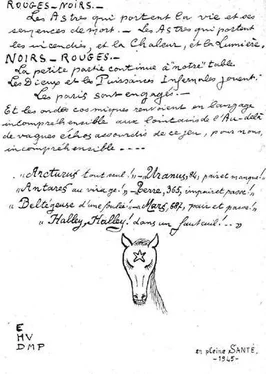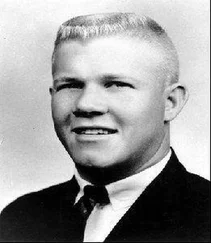Minutes before ten p.m., after Massu had just climbed into bed, the telephone rang. “I still remember that call as if the crackle of the bell rang in my ears today,” he said many years later. At that hour, he knew it could only mean one thing. This was not, as he put it, another “stabbing in the vicinity of Montmartre.” Massu took the receiver with the steely composure of a gambler trying to bluff a rogue cardsharp.
On the line was Secretary Canitrot at the Brigade Criminelle. Without relaying the details of the discovery at rue Le Sueur, Canitrot urged the boss to come as quickly as possible and sent over a car right away. Fifteen minutes later, a long black Citroën 11 CV was waiting outside Massu’s residence, the chauffeur with a hand at his cap.
Bernard wanted to tag along, as he sometimes did on the most serious or interesting cases. The commissaire agreed. Massu, a stocky man in his fifty-fifth year, with a shock of black hair and a dark mustache, put on his black overcoat and gray fedora. The two Massus, each wrapped up for the night chill, hopped into the car and drove across the city that, years before, would have been swirling with activity. That evening, however, Paris looked, as Massu put it, “somber and deserted.”
The city was suffering the fourth year of the Nazi Occupation. Huge red and white banners emblazoned with a black swastika had flown atop the Eiffel Tower, the Arc de Triomphe, and many other landmarks and buildings near Petiot’s town house. White placards with Gothic script directed traffic, mostly German and many of them, in that area, Mercedes-Benzes or Citroëns with small swastika flags on the fenders. The few people on the streets after the official ten p.m. curfew were Germans, “friends of the occupiers,” and the “workers of the night.” A brothel exclusively for Nazi officers was located just around the corner from Petiot’s property.
As the car pulled up to 21 rue Le Sueur, a single streetlamp, hooded for the wartime blackout, cast a dim bluish light on the activities of the police, which, as Massu already realized, were inspiring an “uneasy curiosity” among the street’s residents. Some officers controlled the crowd eager to watch from balcony windows; others followed the commissaire inside the town house. Policemen were now arriving every few minutes.
Massu entered the mansion, which had a grand salon, a petit salon, a large formal dining room, a billiards room, a library, six bedrooms, and two kitchens. The house had previously belonged to Princess Marie Colloredo-Mansfeld, a sixty-seven-year-old Frenchwoman whose husband’s family had borne the title of imperial prince since 1763. The French actress Cécile Sorel, the comtesse de Ségur and doyenne of the Comédie Française, had lived there in the 1930s, a neighboring concierge was telling people. This would be claimed for years, but it is not accurate. Sorel had only rented the house to store her extensive wardrobe and trunks of memorabilia from her long career on the stage.
The current owner of the property was far less known to the general public than either the princess or the actress. “The name Marcel Petiot meant absolutely nothing to me,” Commissaire Massu admitted. It was the first time he had even heard it.
From what Massu could tell, the owner was an assiduous collector of fine art. Many of the rooms boasted a splendid array of crystal chandeliers, oriental rugs, antique furniture, marble statues, Sèvres vases, and oil paintings in gilded frames. At the same time, there was a startling state of neglect. The rooms were not only dusty and full of cobwebs, but also, in some cases, the furniture was turned over or stacked in corners as if at a flea market. In several rooms and corridors were torn wallpaper, loose baseboards, and dangling panels. Massu saw exquisite Louis XV furniture alongside filthy couches with visibly protruding springs.
When one officer warned that the case would most likely turn out to be appalling, Massu was unfazed. He had heard this before. In fact, almost every time a new crime was discovered, someone usually noted that it would be a “terrible histoire.” He had no doubt that this might well be the case. As chief of the Brigade Criminelle, he was used to investigating disturbing affairs.
Still Massu was taken aback at the macabre spectacle in the basement of 21 rue Le Sueur: the half-burned skull in the furnace, the pile of tibias, femurs, and other bones on the floor. A foot, Massu saw, was “blackened like a log that had been slowly consumed.” A dismembered hand, curled up tightly, “grasped the thin air in desperation.” A woman’s torso lay there, with the flesh “gnawed away to reveal the splinters of the ribcage.” The stench—“the sinister odor of roasted human flesh,” as he put it—gripped his throat.
A few steps away, Massu found a shovel, a dark-stained hatchet, and then, underneath the stone stairs, a gray bag containing the left half of a decomposed body, minus the head, foot, and internal organs. Massu did not know how to describe the ghastly site other than by using a reference to medieval literature. The basement of the elegant town house looked like a scene from Dante’s Inferno .
EXITING into the courtyard, Massu, Bernard, and a couple of detectives, including Inspector Principal Marius Battut, entered one of the smaller buildings in the back. In the first room was a polished desk, along with two leather armchairs, a lounge sofa, and a small round table topped with magazines. A cupboard full of medical supplies stood against one wall; against another was a glass-lined bookcase in which medical treatises were shelved. What particularly struck the commissaire, however, was the room’s appearance: It was cleaner, tidier, and in much better condition than the more stately main building. It also seemed to have been recently renovated.
Opening a second door, located near one of the bookshelves, Massu exited into a narrow corridor, about three feet in width, which led to another door, this one with a thick chain and padlock. The investigators entered. It was a small, triangular room, about eight feet on the longest side, six on the shortest. The walls were thick, two of them of rough cement and the third covered by beige wallpaper. There were no windows or furniture, only two unshaded lightbulbs and a plain metal cot. Attached near the corners of each wall, about one meter from the ceiling, were a number of iron hooks.
A gold-trimmed double wooden door on the far wall appeared to lead to some grand salon, but when one of the inspectors tried to open it, the doorknob simply turned around. With the help of a crowbar, the men ripped the door from the hinges to discover that it had been glued there. To the right of this false door was a bell, which did not work either. Actually it was not even connected, as its wires had been cut from the outside. As for the door through which the inspectors had entered, Massu noticed that it had no handle on the inside.
Examining the beige wallpaper, which looked freshly applied, Bernard peeled it back and discovered a viewing lens fitted in the wall at a height of almost six feet. The purpose of the room was not clear, but there was already a disturbing hunch that this small space with its iron hooks, many decoys, and virtually soundproof walls might well be where the victims had met their demise.
After retracing their steps to the courtyard, Massu and his team entered the old carriage house, which had been converted into a garage and crammed with tools, boards, slop pails, paintbrushes, gas masks, and old mattress springs. A sliding door in the back led to another building, probably the former stable. There, on the ground, beyond a pile of rusty scrap iron was a metal cover that hid the night’s most horrific discovery.
It was the entrance to a pit. A newly greased pulley, with a hook and a thick rope tied to form a noose, hung over the hole. A horrible stench left little doubt as to what lay inside. Massu, nevertheless, climbed down the wooden ladder, watching each slippery step, and landed in the middle of a revolting mix of quicklime and decomposing bodies of varying stages—the dumping ground, in effect, of a veritable slaughterhouse.
Читать дальше












